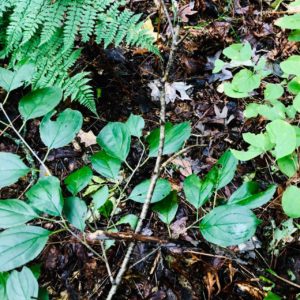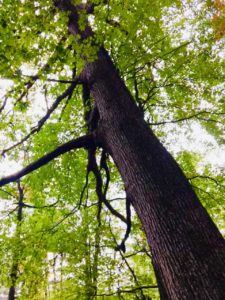It’s a clear September day when I go to my phenology spot for the first time. The sky is clear of clouds, the air even starting to heat up as we cross from the morning into the early afternoon. The walk from Redstone Campus down to Centennial Woods isn’t a difficult one, but in the warmth I find myself wishing I had left my vest at home, or brought a water bottle. Following Carrigan Drive down across East Avenue and past the Police Department, the entrance to Centennial comes up on the left side. My spot, marked in the center by a towering White Oak, is about a 7 minute walk back into the woods. If you take the trail that follows the creek to the clearing dominated by various types of conifer trees and then turn left, cross the stream and continue along it until you come to a path that t-bones the main trail – that is the rough area of where my phenology spot is.
The reason for choosing this place isn’t necessarily specific or calculated. During previous trips to Centennial, I liked the vibe the area had, the way the trees filled the spaces. It became familiar, and since I don’t have a car or a bike – Centennial was pretty easy access. I ended up exploring a part of Centennial that I had never seen before, and the big White Oak really was what caught my attention for the specific spot. Its sheer size definitely stood out among the other trees, which were considerably skinnier – so much so that it was the first thing that caught my eye as I started to walk up the small hill.
Most of the surrounding trees were hardwoods, dominated specifically by Red, Sugar, and Norway Maple. Both varieties of Buckthorn can be found in abundance in the understory, and in one of the attached pictures you can clearly see the overlap of a Common Buckthorn and a Glossy Buckthorn growing right next to each other. Besides that, there are three main varieties of ferns I observed that provide a lot of groundcover, as well as maple sprouts and saplings. There is some grass, and towards the creek-facing side of the area, there is a great deal of shrubbery that I couldn’t identify on either of my visits to the place. A few coniferous trees also inhabit the area, including an Eastern White Pine and a few Eastern Hemlock. Additionally, there are a few large downed trees that have a lot of moss and fungal species growing on them. The logs once belonged to coniferous trees, likely pine trees. The ground cover mostly falls in the realm of Oak and Maple leaves, with very little of it able to be attributed to dropped needles.
The air was cold that day, with thick cloud cover. Periodic sprinkles of rain found their way into the forest as I observed my surroundings, but nothing too strong. The darkness of the wood and the vibrant greens were products of rain from the night before, and the air had a fresh, clean smell to it, underlaid with a small hint of wet dirt. It was very quiet, and devoid of animal activity, so much so that I don’t think I even heard a bird calling in that area of the woods.
Its a gloomy October day when I leave my place for the second time, my visiting family happily commenting on how beautiful it is. I must agree – there is nothing quite like the tranquility of the woods after a good rain.









